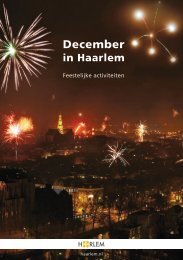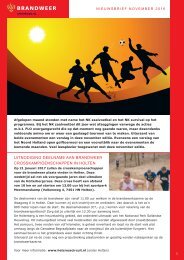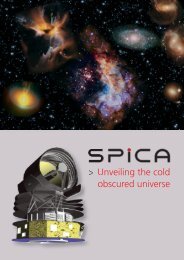SRON_Spectrum_2016
You also want an ePaper? Increase the reach of your titles
YUMPU automatically turns print PDFs into web optimized ePapers that Google loves.
or star, space-time is curved. As a result of this everything in the vicinity<br />
is inclined to move towards the object. That is why the moon orbits<br />
the earth and the earth orbits the sun. Of course we have known<br />
about this phenomenon far longer under the name of gravity. Einstein,<br />
how ever, with his general theory of relativity, was the first to describe<br />
gravity as a curving of space-time.<br />
Ripple<br />
His theory gave rise to a hypothesis that was only proved one hundred<br />
years later. Rapid changes in the quantity of matter at a certain location<br />
cause space-time to ripple, which is comparable with the ripples<br />
that arise if you throw a stone in the pond. These space-time ripples<br />
are known as gravitational waves. They arise, for example, if neutron<br />
stars or black holes collide with each other. As such extreme phenomena<br />
provide insights into how gravity works and the formation of<br />
galaxies, scientists are very eager to study gravitational waves.<br />
With the small blocks experiment, in which <strong>SRON</strong> is playing an important<br />
role, they hope to be able to do that eventually. Whether that will<br />
actually happen largely depends on the test mission currently in progress.<br />
On 3 December the European Space Agency ESA launched the<br />
LISA/Pathfinder probe. In a piece<br />
According to Einstein of no man’s land in the solar system<br />
it will be examined whether<br />
rapid changes in the<br />
quantity of matter the two gold-platinum blocks on<br />
should cause ripples board can travel through space<br />
completely undisturbed. If that is<br />
in space-time<br />
the case then it will have been<br />
proven that the blocks in space can only be disturbed in one way: by<br />
gravitational waves. That will give the green light for the eLISA mission<br />
in 2034.<br />
are looking for gravitational waves with the help of laser beams.<br />
At these locations two laser beams constantly pass back-and-forth<br />
through tubes that are perpendicular<br />
to each other.<br />
The blocks move in<br />
exactly the same manner Upon their return the beams<br />
through space like<br />
merge. From the light wave<br />
synchronized divers in pattern of the resulting beam<br />
you can see whether a gravi -<br />
a cosmic competition<br />
tational wave has passed<br />
through in the intervening time. That is because the detector is set up<br />
in such a way that the two beams usually cancel each other out. How -<br />
ever, if a gravitational wave passes through the setup then this briefly<br />
deforms the setup as a result of which the waves will no longer cancel<br />
each other out.<br />
New era<br />
It took years before gravitational waves were finally unmasked using<br />
this method. On 11 February <strong>2016</strong> the world of physics threw a party<br />
when researchers announced that the Ligo detector had measured<br />
a passing wave on 14 September 2015. The wave had originated<br />
from two black holes that had merged 1.3 billion years ago. According<br />
to the scientists involved, the discovery marked a new era in physics<br />
and astronomy in which measurements of gravitational waves could<br />
7<br />
<strong>SRON</strong> <strong>Spectrum</strong><br />
Why will such a delicate experiment be carried out in distant space?<br />
Although gravitational waves occur everywhere they are very difficult<br />
to observe. That is first and foremost because gravitational waves in -<br />
fluence everything in an identical manner. They can temporarily stretch<br />
a test object but because they stretch your ruler by exactly the same<br />
amount you will not measure the difference.<br />
There are many different ways to circumnavigate this problem. The<br />
Ligo detector in the US and the Virgo detector in Italy, for example,<br />
Simulation of gravitational waves during a collision between black holes (ESA).






